Membrane expansion tank for cold water. How to choose an expansion tank for water supply systems
In suburban areas that are not supplied with a central water supply, it becomes necessary to supply water on their own. However, digging a well or a well and simply installing an electric pump is clearly not enough for several reasons: the water pressure is maintained at a limited distance, which decreases even taking into account the depth of the well, the number of inclusions for a certain period of time is strictly regulated in order to avoid premature failure. To maintain pressure in the autonomous system, an expansion tank for water supply is included, which accumulates a certain amount of liquid and allows the pump not to turn on when the tap is opened for a short time. In addition, in case of power outages, a supply of water is created, water hammer is compensated, which protects household appliances: boilers, washing machines.
Tanks for water supply are metal containers, one part of which is filled with air and the other with liquid. Horizontal or vertical orientation does not make a fundamental difference; for each specific case, such a form is chosen that will most conveniently install the unit in the place intended for it.
According to the principle of operation, there are expansion tanks:
- open type;
- membrane (closed), also called hydraulic accumulators, or expansion mats.

The scheme of connecting tanks to the drinking water supply system depends on the type. The first is simply a large capacity. There is a cover here, but it does not serve to seal, but rather as a protection against debris. The tank is located at a point significantly higher than the place of parsing, most often in the attic, and when the tap is opened, the water flows by gravity. These devices are used very rarely, as they have a number of significant drawbacks:
- it is necessary to install an automatic relay to turn off the pump when the tank is filled;
- open contact with air leads to the ingress of oxygen into the water, which contributes to the corrosion of metal parts;
- it is required to insulate the room with the tank installed in order to prevent it from freezing in winter.
In hydraulic accumulators, a metal container is divided by a special membrane into two parts, one of which is pumped with air, and the other is designed for water. The design is sealed, the liquid takes up more and more space as it enters, stretches the membrane and compresses the adjacent chamber. When the air resistance reaches the set value, the pump automatically stops and resumes after the tank has been depleted and the pressure has dropped to a certain minimum. It should be borne in mind that the maximum volume of water is only a third of the total capacity of the unit, that is, for example, expansion membrane tanks for water supply of 100 liters accumulate 33 liters of liquid.
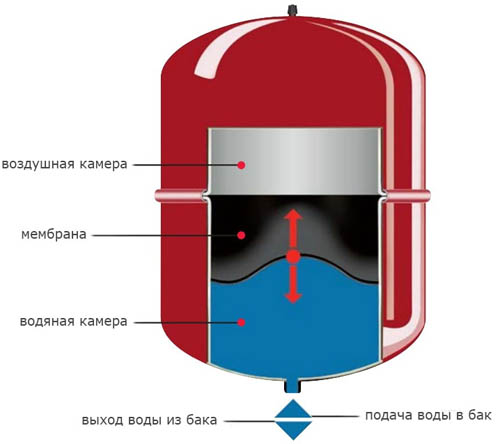
The main criteria for choosing a hydraulic accumulator
To calculate the optimal volume of the tank, you need to determine the number of consumers of the future water supply. And this does not mean the number of people living in the house, but the connected Appliances (Dishwasher, boiler) and disassembly taps (toilet, faucet, shower). The calculations take into account the probability of the simultaneous use of several points, according to their results and practical experience, the experts deduced the following scheme:
- up to 3 consumers - 20–24 l;
- 4–8 - 50–60 l;
- over 10-100 liters and more.
If the developer offers to buy tanks for automated water supply systems - we are talking about a station consisting of a pump, a hydraulic accumulator and a control unit for the complex. For this purpose, a horizontal tank is usually chosen (it is easier to mount it on a surface pump), equipped with a check valve that prevents arbitrary discharge of water into the well after shutdown. In addition, the technical documentation must indicate that the accumulator can be used for drinking water supply. The words “do not comply with DIN1988 standards” in the passport of an imported unit mean that it is intended only for industrial or domestic water.
It is important to pay attention to the possibility of repair and maintenance of the expander, and not just to study the prices for expansion tanks for water supply systems. In particular, hydroaccumulators are of two types: balloon and membrane. This division is rather conditional, since both of them have a membrane in their design, which in the first case is attached at the inlet, is a replaceable part and does not allow water to come into contact with the metal case, and in the second case it is installed deep in the tank and cannot be repaired. It is preferable to purchase a non-corrosive balloon hydraulic tank, where almost all parts are replaceable.
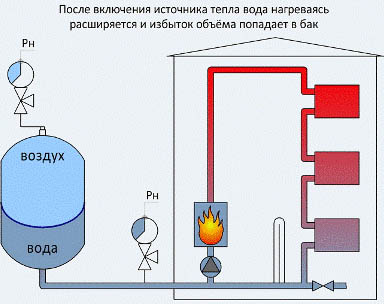
Heating Options
Outwardly, all household accumulators look the same, however, types for heating are designed not to create the required pressure, but to prevent its increase. The different arrangement of tanks for cold and hot water supply systems does not allow replacing them with each other. In the process of heating the coolant, its volume increases, and the pressure in the heating pipes increases. In order to prevent leaks, as well as to remove air, an expansion tank is connected to the circuit, which receives excess fluid.

An open tank can be placed in a heating system with natural circulation. It is rarely used due to the abundance of inconveniences that arise during use. The tank is located only in highest point heating circuit, direct contact of water with air contributes to the corrosion of metal parts, the coolant evaporates, the level of which has to be monitored and topped up as needed. Membrane tanks are installed at any point of the closed loop. To maintain stable heating operation, the units are equipped with a compressor; air is bled when the pressure rises or is pumped in when it is lowered. In addition, the evaporation of the coolant from the sealed tank is excluded.
When calculating the capacity of the expander, it should be taken into account that when heated, the volume of water increases by approximately 0.3% every 10 °C. It is also necessary to pay attention to whether the selected model supports the operating parameters of the system and the type of coolant. Specifications are usually indicated in the accompanying documentation.
For example, the small Reflex tanks of the N and NG series are designed for closed heating circuits using water or a glycol solution up to 50%. The membrane in all variants is fixed, nominal volume from 8 to 5,000 l, maintained pressure 6, 10 or 16 bar, operating temperature of the tank 120 °C, membranes - 70 °C.
The cost of equipment varies depending on its capacity:
- NG 18 (12 l, 3 bar) - 1,440 rubles;
- NG 50 (50 l, 6 bar) - 4,410 rubles;
- NG 100 (100 l, 6 bar) - 9,630 rubles.
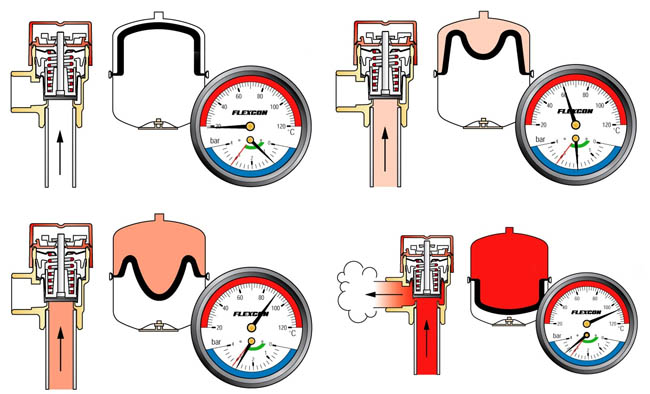
Expanzomats for hot water supply
Basically, boilers are installed in autonomous water pipes for heating, but there is an option when liquid from the heating system is used for hot water supply. In this case, it is important to choose the right expansion tank, which must not only support the desired functional parameters, but also meet additional requirements. The membrane and other parts that come into contact with water are made of materials that meet hygienic standards for devices working with drinking liquid.
Products of domestic manufacturers
Dzhileks tanks for heating and water supply systems successfully compete with the products of well-known foreign companies, not losing at all in quality, but offering the consumer hydraulic accumulators at lower prices. Expansion tanks for closed circuit with steel body, EPDM diaphragm removable on units from 24 l. Depending on the nominal volume, the price is: 18 liters - 1170 rubles; 50 l - 2750; 100 l - 5300.
Another Russian company, whose main products are heating boilers, offers customers an Evan membrane tank. Hydraulic accumulators of the same class produced by Evan and Gileks cost almost the same: a variant with a nominal volume of 100 liters and a maximum operating pressure of 10 bar - 3,250 and 3,400 rubles, respectively.
The value of the expansion tank for water supply in an autonomous system
To date, an autonomous feeding system cold water for a private house or cottage has become quite widespread and is no longer a novelty for anyone. And all because these devices have proven their reliability and effectiveness in practice, however, it should be noted that to maintain them in working condition, special mechanisms are needed, about which the so-called "unenlightened layman", that is, a person who throughout his life used exclusively centralized water supply at home, does not even guess.
Take at least into account the fact that the operation of an autonomous water supply system for a private house or cottage will be able to function for a long period of time only when it is ensured that an expansion tank (special tank) for water supply is included in it (we are talking about them and go) - its required volume (100, 200 liters or less) will be selected individually. Now it is possible to purchase any suitable model without any difficulties, however, in order to purchase a suitable model, it is still necessary to have a general understanding of the types of equipment and a clear understanding of the principle of operation of this device.
In addition, choosing a suitable container option is only a smaller part of the matter - the greatest difficulty is connecting the expansion boiler to an autonomous system.
How does the expansion tank work and how is it arranged (regardless of the volume of the special tank - 100, 200 liters or less)?
The main function of this device is to maintain pressure in the system that supplies water to a private house or cottage. In most cases, closed membrane-type devices are used for water supply. Rexpansion tank for water supply of this type -This is a container with a rubber membrane built into it, which, in turn, divides the expansion (storage) tank, regardless of what the volume is - 100 liters or less, into two cavities - one of them will be filled with water, and the second with air . After the system is started, the electric pump will fill the first chamber. Naturally, the volume of the chamber in which the air will be located will become smaller. According to the laws of physics, when the volume of air in the tank decreases (again, regardless of whether the volume of the tank is 100 liters or less), the pressure will increase.
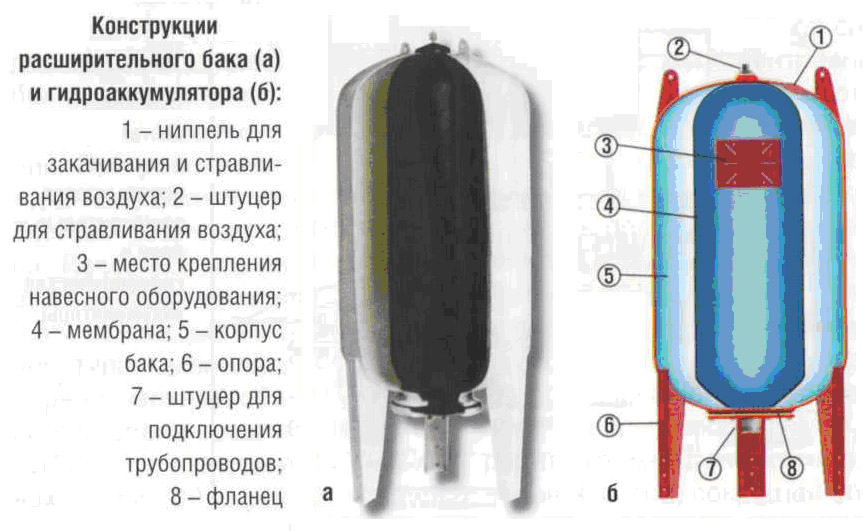
When the pressure reaches a certain level with a subsequent increase, the pump turns off automatically. It can only be activated again if the pressure drops below the set value. As a result, water will begin to flow from the water chamber of the tank (separate container). A similar mechanism of action (its constant repetition) is automated. The pressure indicator is controlled by a special pressure gauge, which is installed on the device. It is possible to change the initial settings.
The main functions of an expansion tank built into an autonomous water supply system (as a special container) are as follows.
A membrane expansion tank (special container) installed in a system or a dacha performs several functions at once:
- Ensuring stable pressure in the event that at a certain moment the pump does not function.
- The container protects the water supply system of an honest house or cottage from a likely hydraulic onslaught, which may occur due to a sharp change in voltage in the network or if air enters the pipeline.
- Saving under pressure a small (but strictly defined) amount of water (that is, this device, in fact -) .
- Maximum reduction of wear of the water supply system of a private house.
- The use of an expansion tank allows you not to use the pump, but to use the liquid from the reserve.
- One of the most important purposes of this kind of devices (in this case we are talking exclusively about membrane expansion tanks) is to ensure that the most clean water is supplied to residents of a private house.
Varieties of expansion (membrane) tanks
There are two main types of these containers.
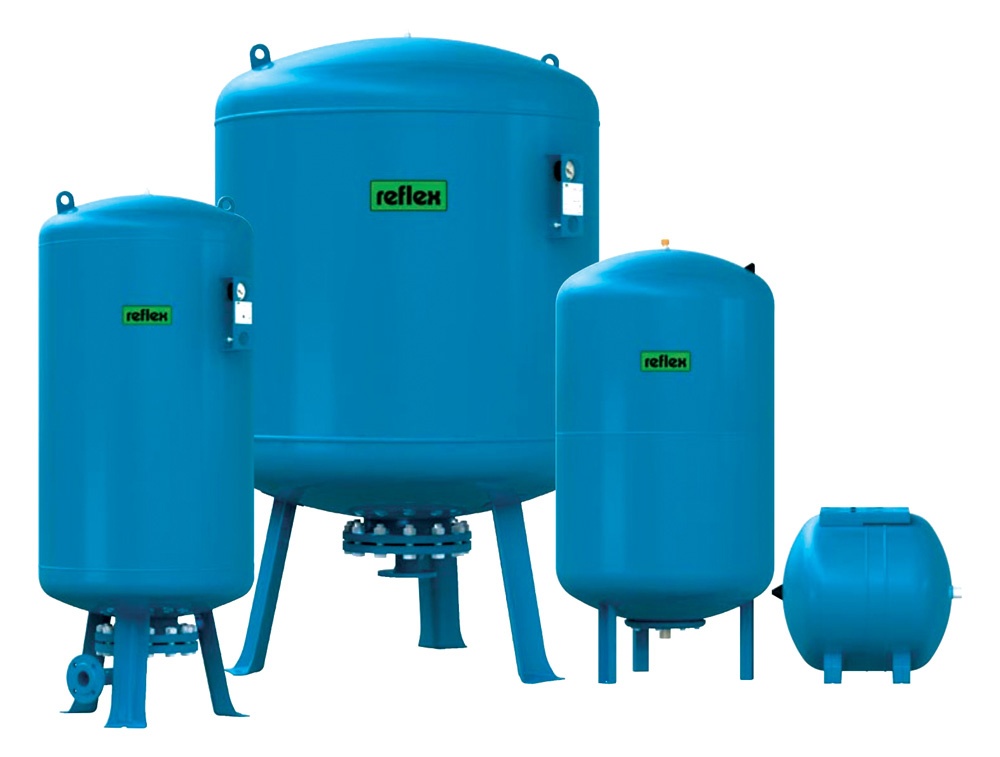
- Expansion tank with replaceable membrane. As the name implies, the main characteristic feature is to replace the membrane, which provides certain advantages. Its recess is carried out by means of a special flange, fixed with several bolts. There is some nuance - in devices designed for a large volume, in order to stabilize the membrane, it is fixed to the nipple. In addition, the liquid that fills the tank is present inside the membrane and does not interact with the inside of the device - in turn, this property makes it impossible for metal corrosion and water quality deterioration. Naturally, thanks to this feature, tanks with a replaceable membrane function much longer. It should be noted that such devices are made in both horizontal and vertical versions.
- storage tankequipped with a fixed diaphragm. Naturally, such models are inferior to the above devices in a number of parameters. Firstly, due to the fact that water comes into direct contact with the inner wall of the tank, metal corrosion and water pollution occur. The membrane, if it fails, cannot be replaced -storage tankyou will have to buy a new one (the difference in price is very noticeable). Some models are covered from the inside with special moisture-resistant paints, but they do not provide any protection at all. There is also a horizontal and vertical type of device.
How to make a competent choice of an expansion tank?
No matter what, the main technical characteristic when choosing an expansion tank is its volume. And already the need for a certain amount of volume is dictated by a wide variety of conditions:
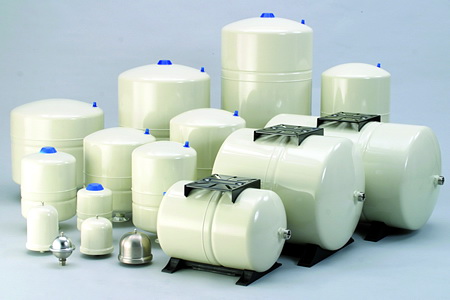
Approximate figures given by leading experts as an example:
The most common average family, which includes no more than three people, needs water supply, the pump capacity does not exceed 2 cubic meters. m / h, then the most reasonable choice would be to purchase an expansion tank with a capacity of 20 to 24 liters. With an increase in the number of consumers to eight people, it is worth purchasing a device with a volume of less than 50 liters. There are more than ten consumers - at least 100 liters are needed. These are the most optimal values - and not a lot, and not a little. In the event that you are in doubt - it is better to take with a margin, a little more - this certainly will not damage your autonomous water supply system in any way.
Important! When choosing an expansion tank, it is necessary to take into account the need for a reservoir to store a certain amount of water.
Manufacturer brand selection
Remember the most important thing: the water supply system is not something you can save on. In the event that you purchase a low-quality expansion tank (even if at a bargain price), then you should understand that you risk being left without water supply at all for an indefinite time and with the need for very significant financial costs that differ from the difference in the cost of these tanks for a couple " zeros." As you have most likely already correctly understood, the costs will be associated with one that has failed due to the poor quality of the expansion tank.
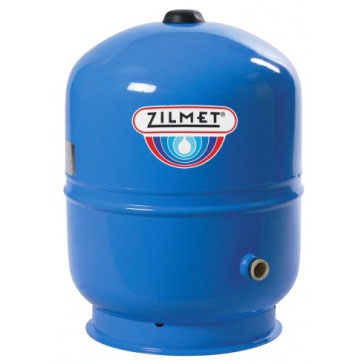
Particular attention should be paid to the quality of rubber - the main component of the membrane (this component affects not only the durability of the device, but also the quality of the supplied water).
As a reliable manufacturer, we can safely recommend the following brands: Elbi, Reflex, Zilmet, Aquasystem.
A few words about how to install an expansion
According to the connection method, it is customary to separate horizontal and vertical tanks. The choice in this case (regarding only this parameter) is based on which device will be easier to place in the room allotted for it.
The water supply tank (expansion tank) is a container used for autonomous heating and water supply. It prevents overpressure and protects the system from water hammer. Expansion tanks are selected individually for each system, taking into account all parameters and characteristics. They must be resistant to increased pressure and not susceptible to corrosion.
The main task of expansion tanks for water supply is to maintain optimal pressure in the system. For these purposes, compensators are used in the tanks, which equalize the load on all parts of the water supply system. The tank and membrane in contact with water are made of materials that do not affect the taste of water. Such materials must be certified and meet sanitary and hygienic requirements.
Tank for water supply: principle of operation.
Inside the expansion tank there is a rubber membrane dividing the tank into two parts. Air is pumped into one, the other part remains empty. The empty part of the tank after starting the water supply is filled with water. The part with the injected air is designed to maintain a given pressure. Air pressure forces water out of the tank into the pipelines, thereby creating a stable state of the system. without drops and overloads.
Expansion tank for water supply: features of work.
Water entering from the well into the tank, being under pressure, increases the membrane and reduces the volume of air, while creating some pressure. After reaching the required pressure level, the pump turns off, water is consumed and the pressure drops. To maintain pressure, the pump is switched on again.
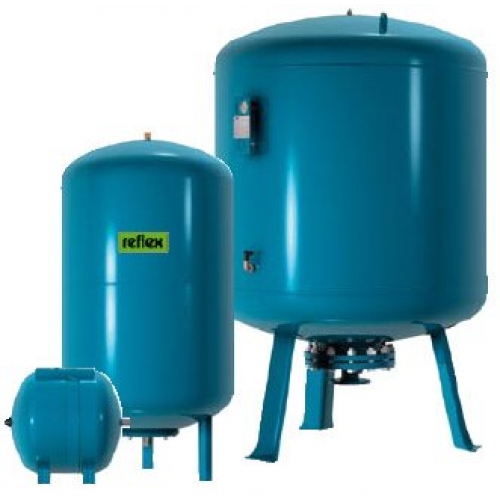
Among other positive qualities, the membrane tank compensates for water hammer, thereby greatly reducing the frequency of switching on the pump. This increases the life of the system elements and saves energy. In addition, when the electricity is turned off, the water supply tank can play the role of an “additional use” device. Those. water will be supplied to the consumer for some time.
Expansion tanks are horizontal and vertical, open and closed. The volume of water, as well as the operating pressure, also vary.
The design of the accumulator is not too complicated: it consists of a hermetically sealed oval-shaped container. Tanks for water supply systems have two internal chambers: air and liquid. These units differ from similar heating units in the presence of a separating membrane, as well as the nature of the material for its manufacture.
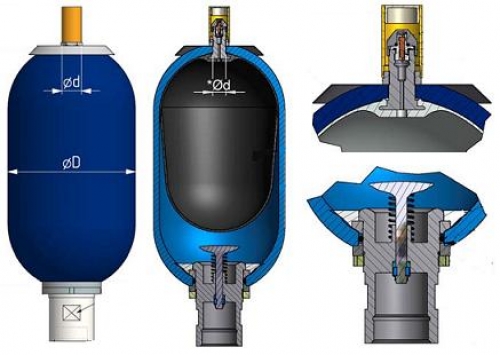
In order not to harm the high quality of drinking water, it is made from environmentally friendly rubber with excellent hygienic properties. As for the size of the tanks, they can be completely different, ranging from 8 to 100 liters.
Water supply tank volume
When calculating the volume of the tank, the initial pressure of the air contained in the empty compartment of the tank and the working pressure (at maximum load) are taken into account. The calculation of the required water pressure is considered fundamental. Although it is enough for the consumer to know the ratio of the volume of the tank to the volume of the entire system, an improperly selected tank leads to an early failure of equipment and pipelines.
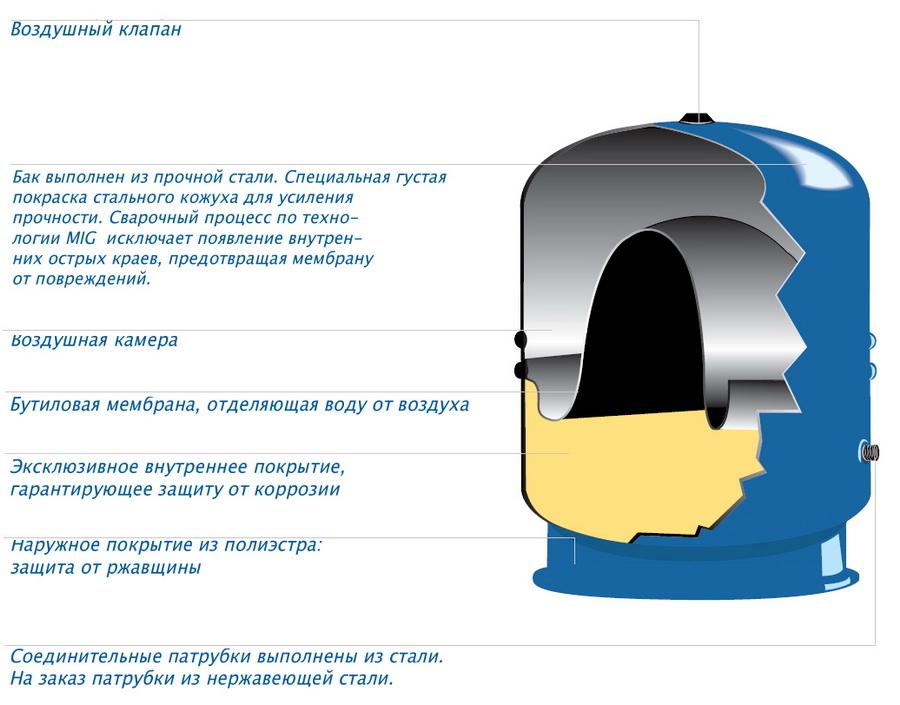
open tank
Such devices are installed at the most elevated points of the heating system (attics, roofs of buildings). The water pressure is compensated only by atmospheric pressure, due to which there is no possibility of adjustment and there is a risk of leakage if there is an excess of liquid. Now open tanks are rarely used.
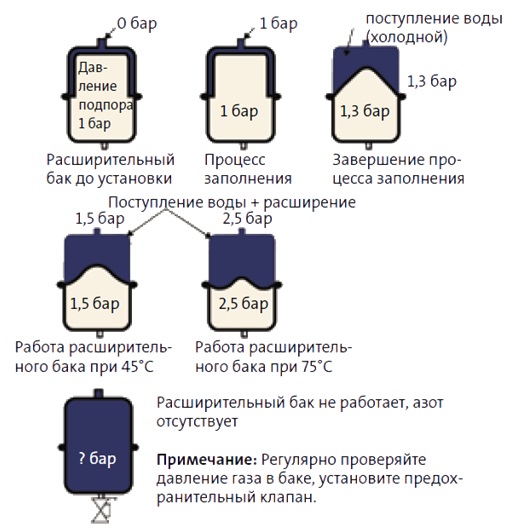
In order for the choice of equipment to be optimal, several rules should be adopted:
- It is necessary to take into account in which particular system the units will be involved.
- It is worth considering what temperature regime is planned.
- Pay attention to the technical parameters of the equipment that were set by the manufacturer.
- If you plan to opt for a membrane type tank, then you need to keep in mind that the pump here has a limited number of inclusions. However, this remark is not relevant if water is to be accumulated under high pressure.
- If a surface type pump is used in the system, then a small hydraulic accumulator should be attached to it, since it has more connections per minute than a submersible type pump.
- Diaphragm tanks for water supply systems with a horizontal installation method should only be used in tandem with surface pumps.
- It is necessary to take into account the specific characteristics of the water supply system.
As a result, the purpose of the tank comes down to several basic principles:
- The equipment helps to avoid water hammer occurring inside the complex.
- With its help, the pressure inside the system is stabilized and maintained at the same level.
- Thanks to the presence of tanks, the functions of the pump are optimized, since it will be protected from too frequent switching on.
- Helps extend pump life.
Today it is difficult to surprise anyone with autonomous water supply. Such a system is very convenient and practical, but for its smooth operation, additional devices are often used, which an ordinary person may not even be aware of. One of these elements is an expansion tank for supplying cold water. There are many different models of such products on the modern water supply market. Therefore, in order not to make a mistake in choosing such a device, you need to understand what the principle of its operation is based on.
Design features and functionality
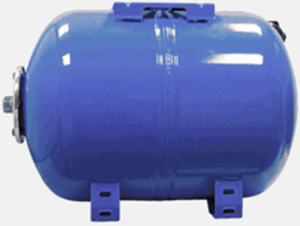 The main purpose of expansion tanks is maintaining a stable pressure level in an autonomous cold water supply system. Most often, a closed-type membrane device is used in water supply systems.
The main purpose of expansion tanks is maintaining a stable pressure level in an autonomous cold water supply system. Most often, a closed-type membrane device is used in water supply systems.
Such a product resembles a tank, inside which a membrane is mounted, made of rubber and dividing it into two separate chambers for air and water. After starting the system by means of an electric pump, the water part of the tank is filled. In turn, the air chamber begins to lose its volume. The less air left, the more pressure builds up.
At the moment when the pressure in the air chamber exceeds the set parameters, the pumping equipment will automatically turn off. In turn, the pump will turn on only when the pressure level in the expansion tank drops below the minimum value. In this case, the cycles of starting and stopping the equipment occur automatically.
For convenience, many models of expansion membrane tanks equipped with a pressure gauge for pressure control. Also, modern devices have the ability to adjust the operating range to the parameters suitable for the consumer. Installing an expansion tank in a cold water supply system provides for the following functions:
- maintaining a predetermined pressure level when the pump is idle;
- protection of an autonomous water supply system from unforeseen water hammers, which can be provoked by a voltage drop in the power supply network or the formation of air locks in the pipeline;
- maintaining a certain volume of water under constant pressure;
- additional protection of the pump against wear.
The installation of expansion tanks for cold water supply allows, with a slight consumption of water resources, in general do not use pumping equipment, but to cover the demand due to the liquid accumulated in the reservoir.
Expansion tank with removable membrane
 The main distinguishing feature of such equipment is the ability to change the membrane as it wears out. To do this, it is simply removed through a special flange device, fixed with several bolts. At the same time, it is important to take into account that in tanks of large volumes, in order to stabilize the membrane, it is additionally attached with the back side to the nipple.
The main distinguishing feature of such equipment is the ability to change the membrane as it wears out. To do this, it is simply removed through a special flange device, fixed with several bolts. At the same time, it is important to take into account that in tanks of large volumes, in order to stabilize the membrane, it is additionally attached with the back side to the nipple.
Another feature of such a product is that the liquid entering the tank, located inside the membrane, which prevents contact with the inner walls of the tank. Due to this, the metal of the device body remains protected from corrosion, which significantly increases its operational life. At the same time, models of both vertical and horizontal types are presented on store shelves.
Expansion tank with diaphragm
A feature of such a device is the division of the tank into two separate tanks using a rigidly fixed diaphragm. Therefore, in the event of its failure, you will have to change the entire product as a whole. In such a container, in the part with liquid, there is direct contact of water with the metal case of the device, which leads to the formation of corrosion.
To solve this problem, the internal walls of the device are opened with special dyes. However, such protection is short-lived and after a while rust still appears on the case. As well as expansion tanks with a removable membrane model with a diaphragm, they are vertical or horizontal.
How not to make a mistake with the choice of the device?
First of all, when choosing expansion membrane tanks for cold water supply, their volume must be taken into account. In addition, we should not forget about the following factors affecting basic parameters of the device:
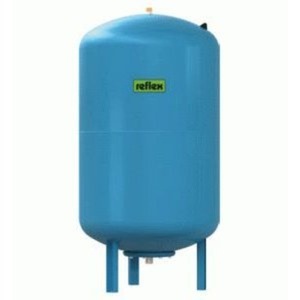
According to the advice of experts, the choice of an expansion tank for cold water supply should be based on the following standard indicators:
- if a family of no more than three people uses water in the house, and pumping equipment produces 2 cubic meters. meters of liquid within an hour, it is better to give preference to tanks with a volume of up to 24 liters;
- if from 5 to 7 people live in private or suburban housing construction, and the pump delivers up to 3.5 cubic meters. meters for an hour, an expansion tank of 50 liters is mounted;
- if the number of residents exceeds 10 people and a powerful 5 cubic meters pump is installed, then it is advisable to use an expansion tank with a volume of 100 liters.
In the process of choosing a suitable model of an expansion membrane tank for cold water supply, it must be taken into account that the smaller the size of the tank, the more often the pumping equipment is turned on and off. Also using a small tank leads to sudden pressure drops. in the water supply system. Plus, such a device should accumulate a certain supply of water resources. Only on the basis of these parameters it is necessary to select the volume of the expansion tank.
You should also be aware that in most tank designs it is possible to install additional water tanks. At the same time, all improvements can be carried out without interrupting the operation of the main water supply system. After installing an additional tank, the total volume of the tank will be the sum of the used tanks.
In addition to technical parameters, when choosing an expansion tank for cold water supply, you need to pay attention to the manufacturer. In pursuit of savings, you can purchase a product that will keep breaking and the homeowner will spend the money to repair it.
Often, to reduce the cost of finished products, companies use cheap materials with low quality. Of particular importance is the quality of the rubber used to make the membrane. This affects not only the operational life of the membrane tank, but also the safety parameters of the water coming from it into the house.
If a device with replaceable membranes is purchased, it is necessary to find out the cost of spare elements. Very often unscrupulous manufacturers for the purpose of profit cost of replacement parts artificially high. In such a situation, you should think about purchasing a model from another company. Often, large manufacturers are ready to take responsibility for their products, as reputation comes first for them. Therefore, it is advisable to give preference to models of expansion tanks of well-known brands.
Independent installation of the expansion tank
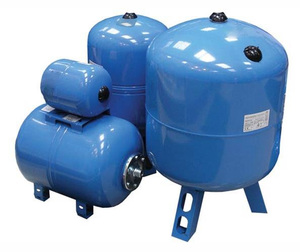 All models of expansion tanks are separated into two main groups, which are determined by the method of connection to a cold water supply. There are vertical and horizontal models on the market. At the same time, there are no special differences in the design of such devices. Placement features are of primary importance water pipes in the room where the equipment is installed. At the same time, during the installation of the membrane tank, one should adhere to certain recommendations of experts:
All models of expansion tanks are separated into two main groups, which are determined by the method of connection to a cold water supply. There are vertical and horizontal models on the market. At the same time, there are no special differences in the design of such devices. Placement features are of primary importance water pipes in the room where the equipment is installed. At the same time, during the installation of the membrane tank, one should adhere to certain recommendations of experts:
- The installation of the expansion membrane tank must be carried out in a place to which there is free access. This is necessary for regular maintenance of equipment.
- It is important to provide for the possibility of dismantling the connecting pipes in order to replace or repair the tank in the event of a breakdown.
- It is important to consider that the diameter of the pipes to be connected must correspond to the inlet pipes of the expansion tank.
- When installing the device, it must be grounded, which reduces the likelihood of electrolytic corrosion.
An expansion membrane tank is installed on the suction side of the pumping equipment. At the same time, there should not be any additional elements capable of introducing hydraulic resistance into the plumbing system.
Expansion tanks are an integral part of any autonomous cold water supply system. Thanks to this device, the required level of pressure in the water supply system is maintained, premature wear of pumping equipment is prevented and a certain supply of water resources is preserved. However, this can only be achieved with right choice and device installation.
Expansion tanks for water supply systems
For water supply systems, underfloor heating
non-flow, without shut-off and drain fittings
diaphragm according to DIN 4807 T3
in tanks with a volume of 60 liters or more - the membrane is replaceable
anti-corrosion coating applied to the surface in contact with water
equipped with a pressure gauge with a diameter of 1000 and more
blue color
pre-pressure 4 bar
The main function of expansion tanks is to maintain constant pressure in water supply systems. The price of this equipment in the Moscow Thermal Company is available to a wide range of consumers.
Structurally, an expansion tank for water supply is a container of a certain volume, inside of which there is a membrane made of a bottle. The neck of the membrane, like the membrane itself, is sealed and connected to the vessel lid by a removable pipe. All expansion tanks for water systems from Reflex are equipped with a membrane that can be replaced in the event of equipment failure.
The main advantages of the expansion tank for water supply
Expansion tank for water supply is very popular in closed systems due to its unique technical and operational characteristics:
- polymer coating perfectly protects the tank from corrosive processes;
- a replaceable membrane makes it possible to significantly extend the life of the equipment;
- Ergonomic design fits perfectly into the interior of the room.
At the same time, the chamber-membrane for water is made of rubber wear-resistant material.
If you decide to buy an expansion tank for water supply, first of all, pay attention to such a parameter as the capacity of the vessel. Depending on the volume of the tank, the expansion tank can be used not only as an additional water tank, but also as the main one.
When buying an expansion tank for hot water supply from our company, you are guaranteed to acquire high-quality, reliable and proven equipment for years, specially designed for water supply systems. All products are certified and meet the highest international standards and requirements.
